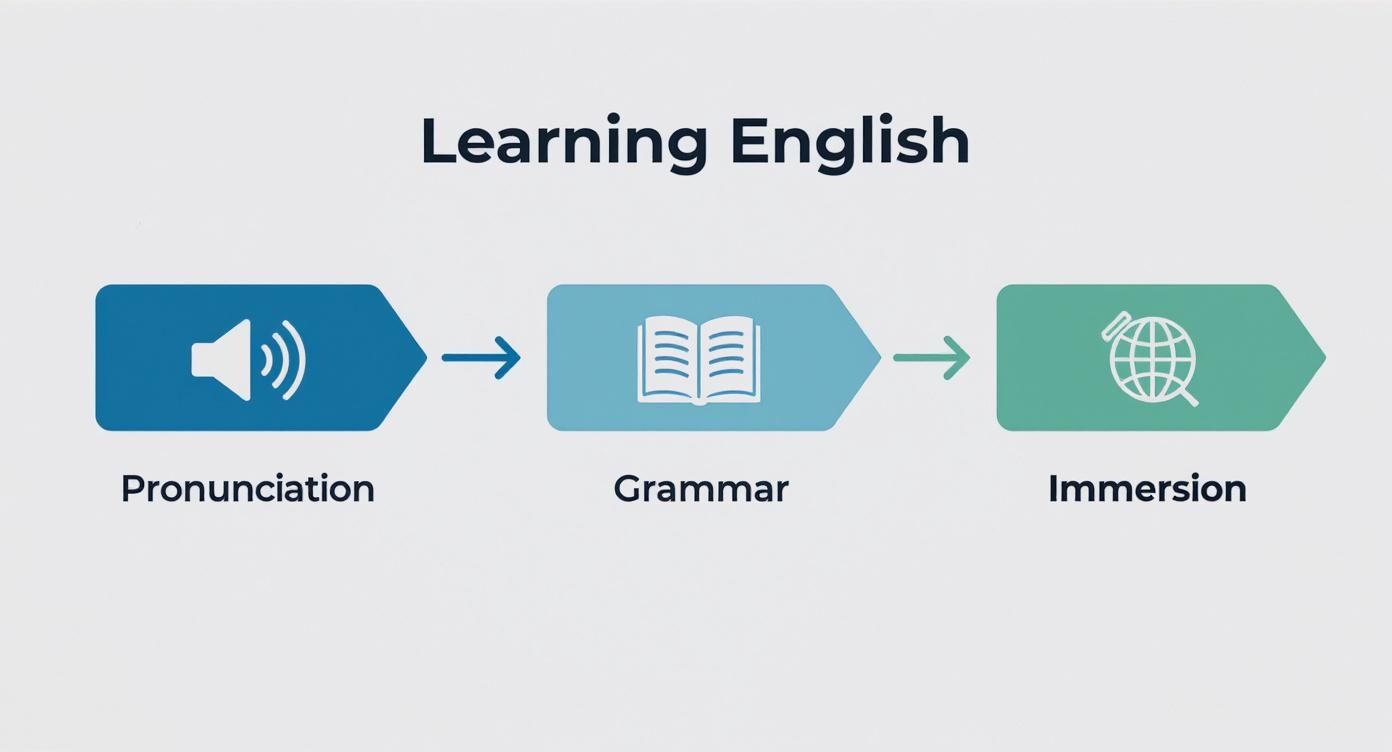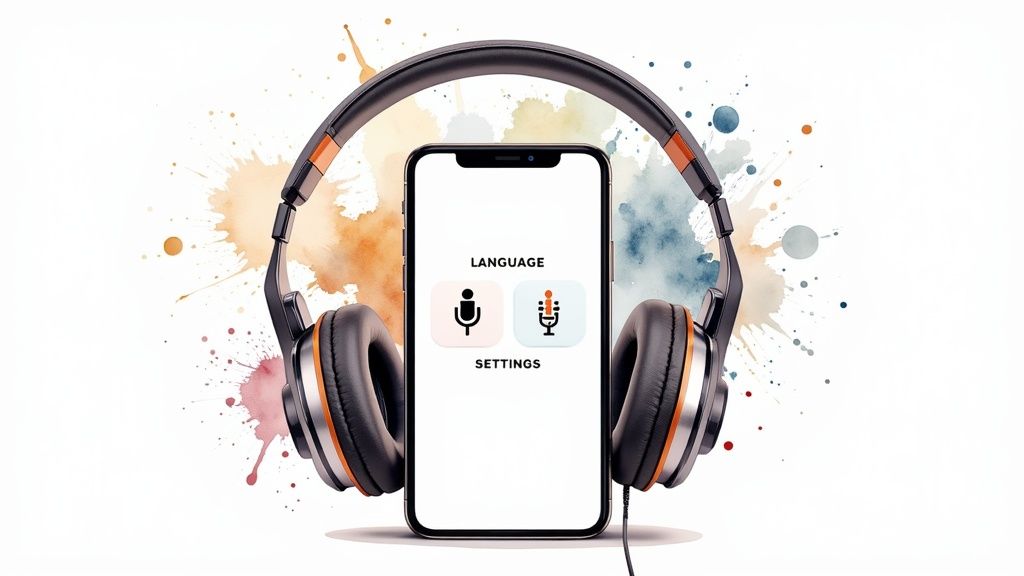Learning English From Spanish A Practical Fluency Guide
A practical guide for learning English from Spanish. Master pronunciation, avoid common grammar traps, and build vocabulary with proven strategies for fluency.


If you’re a Spanish speaker, you’ve got a massive head start when it comes to learning English. Think of it this way: you aren't starting from zero. Your knowledge of a Romance language gives you a solid base in both grammar and vocabulary that other learners just don't have. The trick is knowing how to build on that advantage.
This guide is your step-by-step roadmap. We’ll focus on the key differences—like pronunciation, sentence structure, and everyday expressions—to get you to fluency faster.
Your Proven Roadmap to English Fluency
Learning English as a Spanish speaker isn't like building a house from the ground up; it's more like renovating a house you already know well. You intuitively understand concepts that trip up many others, like verb conjugations and gendered nouns. We're going to use that existing linguistic knowledge as a powerful tool.
Our approach will stand on three core pillars: mastering pronunciation, navigating grammar differences, and making English a part of your daily life. By focusing on these areas with smart strategies, you’ll sidestep common frustrations and make real, tangible progress.
Building on Your Spanish Foundation
Your Spanish background is your secret weapon. Thousands of English words have Latin roots, just like Spanish. This means you have a built-in vocabulary of cognates to draw from—words like nación (nation) and animal (animal). This shared history lets you grasp the meaning of many sentences, even when you’re just starting out.
But this advantage comes with a few things to watch out for. You’ll need to learn how to spot "false friends"—those tricky words that look similar but mean something completely different. You’ll also need to train your ear and mouth to produce sounds that simply don't exist in Spanish.
Your goal isn't to get rid of your accent. It's to develop clear, understandable English pronunciation so you can speak confidently with anyone, anywhere.
Navigating the Learning Path
A structured approach is the key to successfully learning English. You need to tackle the potential challenges head-on. It's also incredibly important to maintain your native Spanish skills while you build new ones. Some research has shown that in English-only environments, a speaker's Spanish can sometimes get a little rusty as their English improves. A balanced approach is essential to becoming truly bilingual. You can dig into the research on bilingual language development to learn more.
This visual roadmap lays out the core stages of your journey, from the basics of pronunciation to full immersion.

As you can see, there’s a logical flow here. You start with the mechanics—the sounds of the language—and gradually move toward using it in real-world situations. Following this path creates a well-rounded learning experience that leads to fluency that actually sticks. And with modern tools like TalkEasy, you can practice every single day and see steady, measurable improvement.
This table breaks down the main challenges you'll face at each stage and the best ways to tackle them.
Key Focus Areas for Spanish Speakers Learning English
| Learning Area | Common Challenge for Spanish Speakers | Effective Strategy |
|---|---|---|
| Pronunciation | Difficulty with sounds that don't exist in Spanish (e.g., short 'i', 'th', 'v' vs. 'b'). | Use phonetics apps and a "minimal pairs" drill to distinguish between similar sounds. Record yourself and compare to a native speaker. |
| Grammar | Overlooking subject pronouns (e.g., "Is raining" instead of "It is raining") and adjective order. | Actively practice using subject pronouns in every sentence. Memorize common adjective order patterns (opinion-size-age-shape-color). |
| Vocabulary | Relying too heavily on cognates and falling for "false friends" (e.g., actualmente vs. actually). | Create a dedicated list of false friends. Focus on learning words in context through reading and listening, not just memorizing lists. |
| Listening | Struggling to understand the fast, connected speech of native speakers and different accents. | Listen to podcasts and watch TV shows with English subtitles first, then without. Use shadowing (repeating what you hear) to train your ear. |
| Speaking | Hesitation and fear of making mistakes, leading to a lack of practice. | Find low-pressure speaking opportunities, like using an AI conversation partner like TalkEasy. Focus on communication over perfection. |
By keeping these specific challenges in mind and applying the right strategies, you can make your learning process much more efficient and effective.
Mastering English Pronunciation

Let's be honest: when you're coming from Spanish, English pronunciation can feel like the biggest mountain to climb. So many English sounds just don't exist in Spanish, which means you literally have to teach your mouth a new way to move. Think of it less like studying for a test and more like training for a sport—it’s all about building muscle memory in your tongue, lips, and jaw.
The goal here isn't to erase your accent. Your accent is part of who you are. The real aim is to be so clear that your words land exactly how you mean them to, giving you the confidence to speak up in any situation.
Tackling Tricky English Sounds
Alright, let's get into the nitty-gritty. Some English sounds are notorious troublemakers for Spanish speakers. Here’s how to approach them.
The Infamous 'Th' Sounds
English has two 'th' sounds, and they’re a classic hurdle.
- The 'th' in 'the' or 'this' (voiced): To make this sound, gently place the tip of your tongue between your teeth and hum. You should feel a slight buzzing or vibration. It’s like a tiny, controlled bee.
- The 'th' in 'think' or 'three' (unvoiced): The tongue position is the same, but this time, there's no humming. Just push air through. It’s a soft, airy sound without any vibration from your vocal cords.
The Short 'i' vs. Long 'ee' Battle
This one trips up almost everyone. The Spanish 'i' is very close to the English long 'ee' you hear in words like “seat” or “meet.” The real challenge is the short 'i' in words like "sit" or "ship."
For the short 'i', relax everything—your mouth, your jaw, your lips. The sound is quick and comes from a bit higher in your throat. For the long 'ee', your mouth is much tighter, almost like you're smiling.
A powerful trick is practicing minimal pairs—words that only differ by that one sound. Saying "ship" and then "sheep," or "sit" and then "seat," over and over again helps train both your ear and your mouth to nail these crucial little differences.
The Secret Rhythm of English
Beyond individual sounds, the entire "music" of English is different from Spanish. Spanish is a syllable-timed language, where each syllable gets about the same beat. It’s very rhythmic and consistent.
English, on the other hand, is a stress-timed language. This means we punch certain syllables, making them longer and louder, while gliding quickly over the unstressed ones. This is why native speakers can sound like they're rushing through parts of a sentence—they're not, they're just reducing the sounds that don't carry the main stress.
The king of these unstressed sounds is the schwa, a weak "uh" sound. You hear it everywhere, in words like "about," "taken," or "pencil." Getting a feel for the schwa is a game-changer; it will instantly make your spoken English sound more natural and fluid. For a deeper look, check out our guide on how to learn an English accent.
Your Pronunciation Practice Toolkit
You can't build new habits without consistent practice and the right tools. Here’s how you can actively train your pronunciation.
- Get Visual with Phonetics Apps: Look for apps that show you diagrams of the mouth and tongue for different sounds. Many now include AI that listens and gives you feedback on how close you are to a native speaker.
- Record Yourself: This might feel strange at first, but it works. Use your phone to record yourself reading a paragraph. Then, find a recording of a native speaker reading the same text and compare. Listen for rhythm, intonation, and those tricky vowels.
- Practice with an AI Partner: A tool like TalkEasy gives you a safe space to just talk without fear of judgment. You can have actual conversations and get immediate feedback on your pronunciation, helping you fix mistakes in the moment and build confidence for the real world.
Navigating Common Grammar Pitfalls
Having a Latin-based language like Spanish as your native tongue gives you a massive head start with English vocabulary. But that same shared history can also lay a few clever traps, especially when it comes to grammar. This is where many Spanish speakers find themselves tripping over small but persistent mistakes.
The best way to think about it is this: English grammar isn't a new set of rules to memorize, but more like a different operating system for a language you already have a feel for.
Let's walk through some of the most common hurdles. We’ll untangle those tricky "false friends," nail down essential pronoun rules, and make sense of the verbs that seem designed to confuse you.
Dodging Deceptive False Friends
Ah, falsos amigos—the ultimate source of awkward and funny misunderstandings. These are words that look and sound almost identical in both languages but mean completely different things. They are easily the most common pitfall for Spanish speakers.
You might, for instance, say you're going to "assist" a conference, when you really mean you're going to "attend" one. It's a classic mix-up that comes straight from the Spanish word asistir. The key isn’t just memorizing a list; it’s about getting a feel for the context where these words pop up.
And it’s more important than ever to get these right. With roughly 1.5 billion English speakers and over 595 million Spanish speakers globally, the chances for both connection and miscommunication are huge. Getting these nuances right makes all the difference in a clear conversation. You can find more fascinating stats on the global reach of these languages.
Let’s look at a few common false friends you’ll want to keep an eye on.
Here’s a quick-reference table to help you spot some of the most common culprits.
Common False Friends for Spanish and English Speakers
| Spanish Word | English False Friend | What It Looks Like It Means | What It Actually Means |
|---|---|---|---|
| Embarazada | Embarrassed | Ashamed, self-conscious | Pregnant |
| Éxito | Exit | A way out | Success |
| Sopa | Soap | For washing | Soup |
| Librería | Library | Place to borrow books | Bookstore |
| Fábrica | Fabric | Cloth, material | Factory |
| Asistir | Assist | To help | To attend |
| Soportar | Support | To help, to provide for | To put up with, endure |
| Actual | Actual | Real, in fact | Current, present |
Getting comfortable with these distinctions is a huge step forward. It’s all about building a new mental habit of pausing for a second before using a word that seems a little too familiar.
The Unspoken Rule of Subject Pronouns
One of the biggest mental shifts for Spanish speakers is getting used to English subject pronouns. In Spanish, the verb ending does all the work. "Tengo hambre" is perfectly clear—the "-o" ending tells you that "I" am the one who is hungry.
English just doesn't work that way. The subject pronoun—I, you, he, she, it, we, they—is almost never optional.
Forgetting the subject is one of the fastest ways to sound like a learner. Make it a golden rule: always state who or what is doing the action. For instance, you can't just say, "Is raining." You have to say, "It is raining."
This rule holds true even when the subject seems completely obvious from what you were just talking about. It’s a non-negotiable part of English sentence structure, and the only way to master it is to practice until it feels second nature.
Decoding Auxiliary Verbs and Phrasal Verbs
Two other grammar points can feel like a real headache at first: auxiliary verbs and phrasal verbs.
1. The Role of 'Do' and 'Does'
In Spanish, you can ask a question just by changing your tone of voice: "¿Hablas inglés?" Simple. But in English, you need a little helper word—an auxiliary verb like 'do' or 'does'—to get the job done.
- Spanish: ¿Trabajas aquí?
- English: Do you work here?
The same logic applies when you're making a negative statement. Instead of simply adding 'no' before the verb, you have to use 'do not' (don't) or 'does not' (doesn't).
- Spanish: No trabajo aquí.
- English: I don't work here.
2. Getting a Handle on Phrasal Verbs
Phrasal verbs are those little two-word combinations (a verb + a preposition) that often feel completely random. Their meaning usually has nothing to do with the individual words. 'Look up' can mean searching for information, and 'give up' means to quit.
The trick here is to stop trying to translate the parts. Instead, treat the entire phrase as a single piece of vocabulary with its own unique definition, just like you would any other word.
Building Your Vocabulary with Smart Strategies

Let's be honest, trying to learn English by memorizing endless, random lists of words is a painful—and ineffective—way to go. It's a bit like trying to cook a gourmet meal by just grabbing random ingredients off the shelf. You might have the parts, but you have no recipe to put them together.
A much smarter approach focuses on building your vocabulary in a way that feels natural, connected, and actually sticks in your brain for the long haul.
The great news? As a Spanish speaker, you're not starting from scratch. You already have a massive head start thanks to thousands of words called cognates—words that look and mean almost the same thing in both languages. Think about it: nación (nation), información (information), and animal (animal) are freebies.
These cognates are your launchpad. But the real skill is learning how to pick up brand new words and remember them when you're in the middle of a conversation.
From Cognates to Real Context
While cognates give you a fantastic foundation, the goal is to move past the familiar and into truly functional English. This is where learning words in context becomes your superpower. Instead of just memorizing the word "book," learn it as part of a phrase like "read a book" or in a full sentence: "I need to return this book to the library."
This simple shift accomplishes two huge things:
- You learn what the word means.
- You learn how people actually use the word in real life.
Think of it this way: when you learn a word inside a real sentence or situation, you’re not just memorizing a definition. You're creating a mental snapshot of its natural habitat, which makes it a thousand times easier to pull out and use correctly when you're speaking.
This is how you avoid that common frustration of knowing a lot of words but struggling to string them together into a smooth, coherent sentence.
The Power of Thematic Learning
One of the most effective strategies I've seen is thematic learning. It sounds fancy, but it just means grouping new words by topic instead of in alphabetical order. Ditch the random A-Z lists and start thinking about real-world situations you'll actually find yourself in.
Try building vocabulary sets around specific themes:
- At the Office: agenda, minutes, follow-up, action item, deadline
- Catching a Flight: check-in, boarding pass, customs, layover, baggage claim
- Ordering at a Restaurant: appetizer, main course, dessert, check, tip
This approach works beautifully because our brains are wired to remember things that are connected. When you learn these words as a group, you create a mental web of related ideas, making them pop into your head right when you need them.
Making Words Stick with Spaced Repetition
Okay, so you’ve learned new words in context and grouped them into themes. Now, how do you keep them from vanishing from your memory a week later? The secret is a brilliant, science-backed technique called a Spaced Repetition System (SRS).
At its core, an SRS is just a smart flashcard system. It drills you on new or tricky words more often, and once you know a word well, it shows it to you less frequently. It’s designed to interrupt the brain's natural forgetting process, systematically moving vocabulary from your short-term recall into your permanent, long-term memory.
The real magic happens when you combine SRS with thematic learning. Imagine creating a digital flashcard deck for your "At the Office" vocabulary. The system automatically figures out which words you're struggling with and makes sure you see them just enough to lock them in. It's the most efficient way to study.
As you get more comfortable, you'll start running into more colorful expressions, like idioms. These are phrases where the meaning isn't obvious from the individual words. Getting familiar with them is key to sounding more natural. For a head start, you can check out common phrases like the ones in our guide to idioms about money.
By focusing on these strategies—using your cognate advantage, learning in context, grouping words by theme, and using spaced repetition—you’ll build a strong, practical English vocabulary that you can actually use.
Integrating English Into Your Daily Life

Let's be honest: real fluency doesn't come from a textbook. It's built day by day, through small, consistent habits woven into your life. Formal study gives you the essential building blocks, but it's daily immersion that teaches you how to actually use them with confidence and natural flow.
The goal here isn't to overhaul your entire schedule. It's about making English a natural part of your world—turning those "dead" moments, like your morning commute or cooking dinner, into powerful learning opportunities.
Create Your Personal Immersion Environment
You don't need to pack your bags and move to an English-speaking country to immerse yourself. Your own home, phone, and daily routine are packed with opportunities. The trick is to start switching things from Spanish to English, one at a time.
A fantastic first step is changing the language setting on your smartphone. It sounds simple, but you’ll suddenly find yourself navigating menus, reading notifications, and using your favorite apps entirely in English. This forces you to learn practical, everyday vocabulary without even trying.
Here are a few more easy wins for "digital immersion":
- A Social Media Makeover: Follow English-speaking creators, news outlets, and artists. Your feed will naturally fill up with the kind of casual, authentic language that people use every day.
- Entertainment in English: Next time you're on Netflix, watch with English audio. Start with Spanish subtitles, then switch to English subtitles, and eventually, challenge yourself to watch with no subtitles at all.
- Podcast Power: Find English podcasts on topics you're already passionate about—soccer, history, business, you name it. Listening on your commute or at the gym is an incredible way to train your ear to the rhythm of spoken English and its many accents.
Practice Real Conversations Without the Pressure
One of the biggest hurdles for any Spanish speaker is finding a place to practice speaking without feeling self-conscious. That fear of making a mistake can be paralyzing, I get it. But this is where modern tools can be a total game-changer, giving you a safe space to find your voice.
AI-powered conversation partners like TalkEasy are designed for this exact purpose. They let you run through real-world scenarios—ordering coffee, nailing a job interview, checking into a hotel—as many times as you need, without any judgment.
The AI gives you instant, gentle feedback on your pronunciation and grammar, helping you fix mistakes right on the spot. It’s like building muscle memory for speaking correctly, so when you have a conversation with a real person, you'll feel much more prepared.
The secret to speaking fluently is volume. The more you talk—even to an AI—the more natural it feels. The objective is to make speaking English feel just as normal as speaking Spanish.
For a deeper dive into building this daily habit, check out our guide with more actionable tips on how to practice English speaking.
Connect with the Global English Community
While technology is an amazing practice partner, the ultimate goal is connecting with real people. The good news is, the internet has made it easier than ever to find English speakers from all over the world.
In Spain, for instance, about 10.4 million people speak English, which is roughly 22% of the population. This can sometimes make it tricky to find local practice partners. But there’s a massive national push for English education, so the community is growing every day.
You can plug into this global network right now:
- Join Online Forums: Hop on Reddit or Discord and find communities dedicated to your hobbies. Jump into the discussions—most people are happy to help you practice.
- Try Language Exchange Apps: Use an app to connect with native English speakers who want to learn Spanish. It's a win-win: you help them, they help you, and you both improve in a supportive environment.
- Game Online: If you're a gamer, join servers where players communicate in English. It's a genuinely fun, low-stress way to practice listening and speaking skills in a fast-paced setting.
Your English Learning Questions, Answered
When you're starting to learn English, especially coming from Spanish, a lot of questions pop up. How long will it take? What's the best way to do it if I'm busy? It's totally normal to wonder about these things, and getting solid answers can clear the path ahead. Let's tackle some of the most common questions I hear from learners.
How Long Does It Take to Become Fluent?
This is the million-dollar question, isn't it? The honest answer is, it really depends. Fluency isn't a finish line you cross; it's a spectrum. Your personal timeline will depend on your goals, how much you expose yourself to English every day, and how intensely you practice.
Think of it less like a race and more like building a house, brick by brick.
For a Spanish speaker starting from zero, getting to a solid conversational level—where you can handle daily chats with confidence—usually takes about 6 to 12 months of consistent work. Reaching a high level of proficiency, the kind you need for complex professional or academic conversations, often takes a few years of deep immersion and study.
What really matters isn't the number of hours you put in, but the quality of that time. Fifteen minutes of active, focused speaking practice is way more valuable than two hours of passively watching a movie once a week.
What Is the Best Method for a Busy Person?
If you're a busy professional or student, the thought of adding hours of study to an already packed schedule can feel impossible. The trick is to find a method that weaves itself into your daily life, not one that feels like another chore on your to-do list.
This is where "micro-learning" and smart immersion are game-changers. Instead of trying to find huge blocks of time, look for the small, empty pockets in your day.
- Your Commute is Your Classroom: Pop in your earbuds and listen to an English podcast or audiobook on your way to work.
- Coffee and Conversation: Use a tool like TalkEasy for a quick 15-minute simulated conversation while you're making coffee. It's a fantastic, low-pressure way to build a speaking habit.
- Go Digital with English: Switch your phone, computer, and social media apps to English. You’ll soak up practical vocabulary in a context you already know inside and out.
The best method is simply the one you can stick with. By filling those small, unused moments with English, you can make incredible progress without feeling overwhelmed.
How Can I Overcome My Fear of Speaking?
That knot in your stomach when you have to speak English? It's the biggest hurdle for so many learners. That fear is completely normal, but you have to push past it to get better. The key is to create safe, low-stakes situations where you can practice without worrying about being judged.
It's like learning to swim. You wouldn’t just jump into the deep end of the ocean. You'd start in a shallow, safe pool. Your speaking practice should feel the same way.
Here are a few ways to ease into it:
- Talk to Yourself: It might feel a little weird at first, but narrating your daily actions out loud in English is incredibly effective. "Okay, I'm opening the fridge now." "Where did I put my keys?" This gets your brain used to forming English sentences on the fly.
- Practice with an AI Partner: An AI conversation tool gives you a private space to mess up. You can stumble, repeat yourself, and try new words as many times as you need, all without an ounce of judgment.
- Find a Language Exchange Partner: Team up with a native English speaker who wants to learn Spanish. It creates a supportive partnership where mistakes aren't just expected, they're part of the process for both of you.
Remember, every native speaker you talk to knows you're learning. They don't expect you to be perfect—they're just impressed you're making the effort.
Should I Focus on Grammar or Vocabulary First?
Ah, the classic chicken-or-egg question of language learning. You absolutely need both, but your focus should shift as you progress. When you're just starting out, building a base of essential vocabulary is way more useful.
Imagine you’re in a new city and desperately need to find a bathroom. Knowing the single word "bathroom" is infinitely more helpful than knowing how to construct a perfectly grammatical sentence. A core vocabulary of the 1,000 most common English words will actually help you understand about 80% of everyday conversations.
Once you have that foundation, you can start layering in the grammar rules. This approach works because you’re learning grammar to express ideas you already have the words for, which makes the rules feel practical instead of abstract. The best strategy is a balanced one: learn new words and the basic grammar to use them at the same time.
Ready to turn learning into a confident speaking habit? TalkEasy provides a safe, effective space to practice real English conversations anytime, anywhere. Start speaking from day one and see your fluency grow. Visit https://www.talk-easy.com to begin your journey.